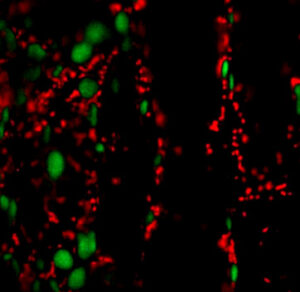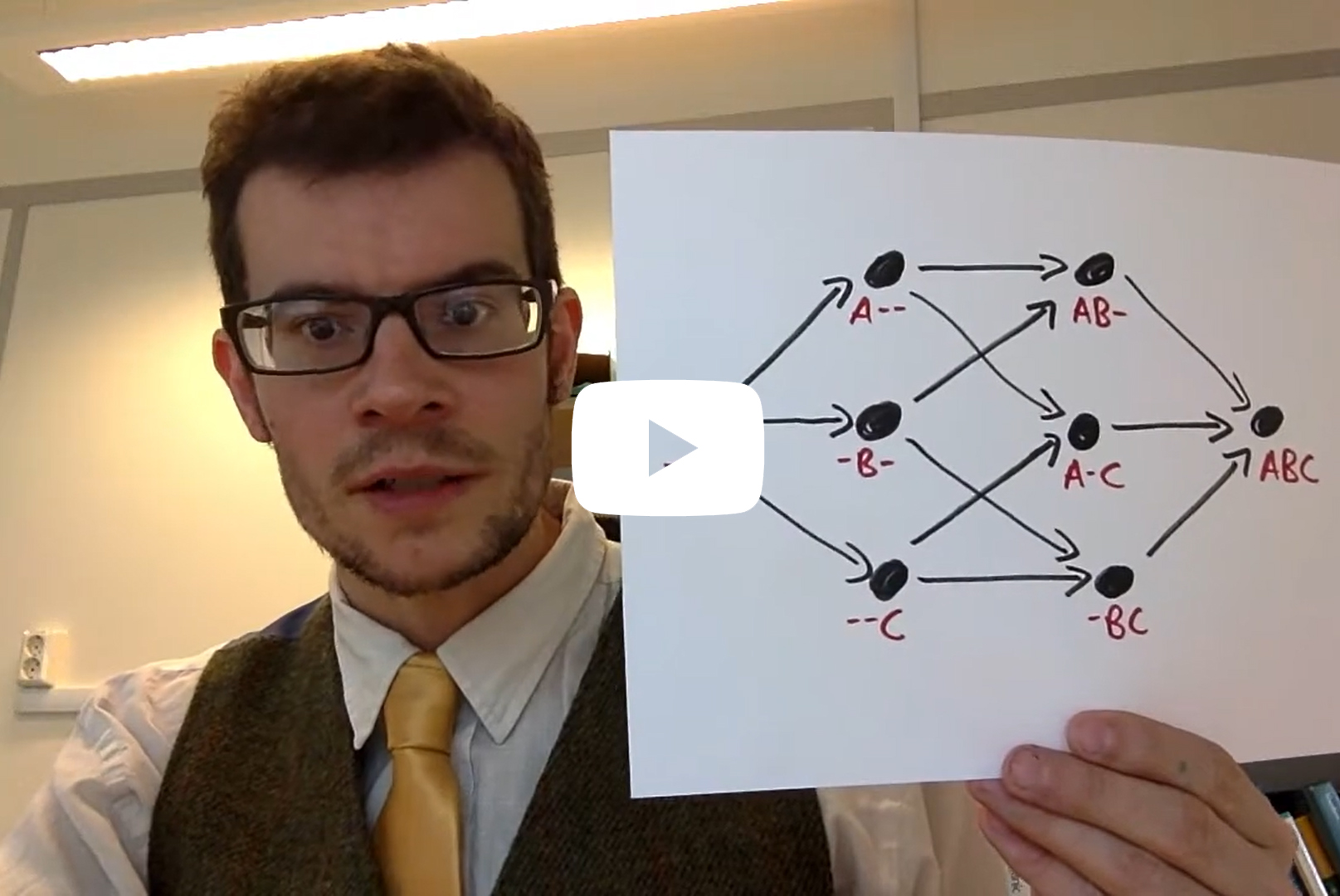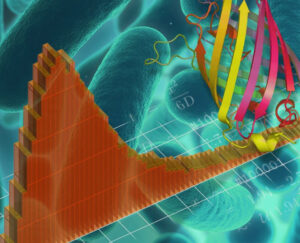We are a research group of scientists interested in combining mathematical and experimental approaches to learn about the biological world, and how we can interact with it to improve human lives. We often work on questions where “blue skies” biological knowledge can be translated into strategies to address disease and crop production. We’re particularly interested in the bioenergetic organelles (mitochondria and chloroplasts) that provide the energy that powers complex life.
“Stochastic” refers to processes that can be thought of as having some random influences — mutations in evolutionary biology, or interactions within the noisy environment of the cell. Randomness is not necessarily unpredictable.
Check the updated list of research foci.
 EvoConBiO: Stochastic control and evolution of organelle genomes
EvoConBiO: Stochastic control and evolution of organelle genomes
The energy required to power complex life is provided by organelles called mitochondria (and chloroplasts, in photosynthetic organisms). Mitochondria and chloroplasts have a rich and fascinating evolutionary history. They were once independent organisms which were captured and harnessed by cells billions of years ago. Since that capture, they have lost many of their genes, either completely or to the “host” nucleus. This transfer of genes is central to how the cell controls its organelle populations, and how the evolutionary game between organelles and hosts has played out over evolutionary time. The genes that remain in modern-day organelle genomes (mtDNA and cpDNA) are central both to our survival and to several devastating genetic diseases.

EvoConBiO is an ERC-funded project exploring how organelle genomes have evolved over time, and how modern-day cells control these populations to survive. We are interested in whether there are “universalities” in the principles governing mitochondria and chloroplasts, and whether these principles can be manipulate to suit human purposes — to use this knowledge to prevent or ameliorate disease and improve crops. We take an interdisciplinary perspective, using modelling, lab work, and bioinformatics to make progress with these fascinating questions.
Some EvoConBiO and related work on organelles:
- Universal principles of organelle evolution (Cell Sys)
- Social networks of organelles (J Exp Bot, Cell Systems, QPB)
- Plant organelle heteroplasmy (PNAS)
- Removing mutant mtDNA with small molecules (Nat Comms)
- Avoiding oDNA meltdown across eukaryotes (PLoS Biol)
- Selfish mtDNA and segregation (Nuc Acids Res)
- OXPHOS and mtDNA segregation (Science Advances)
- Inheritance of mixed mtDNA (Cell Metabolism; blog)
- Mitochondria and chloroplasts in plant cells (Mol Plant)
- MtDNA in inheritance and ageing (Nat Comms)
- MtDNA through cells and generations (Biochem Soc Trans; Frontiers Cell Dev Biol; blog)
- MtDNA gene loss (Cell Systems; blog)
- Nuclear control of stochastic mtDNA (AJHG; blog)
- Mitochondrial variability and its effects (PLoS CB; blog)
- Mitochondria and cell physiology (BioEssays; blog)
- MtDNA segregation in mice (Cell Rep; blog)
- MtDNA segregation in human disease (MHR; blog)
- The mitochondrial bottleneck (eLife; blog)
- MtDNA populations and disease (MHR; blog)
- Drugs to influence mtDNA populations (Pharm Res; blog; Biochem Soc Trans; blog)
- Nuclear control of stochastic mtDNA (AJHG; blog)
- Why do mitochondria form networks? (BioEssays; blog)
We are very interested in how our work can address mtDNA disease and collaborate with clinicians and policy bodies to explore and implement these research pathways.
HyperEvol: Combatting antimicrobial resistance
Anti-microbial resistance (AMR) involves disease-causing pathogens evolving resistance to the drugs we use to treat them. It is a huge and growing societal health burden, and we are interested in how our approaches for modelling and learning about evolution can help understand this process. Our goal is to provide both basic biological insight and clinically relevant information on particular pathogens. Our project HyperEvol within CAMRIA — Combatting Anti-Microbial Resistance with Interdisciplinary Approaches — aims to develop and apply inference methods to learn and predict the pathways by which AMR evolves in different regions and countries worldwide.
Some AMR-related projects:
- HyperHMM, evolutionary inference for TB AMR (and more) (Bioinformatics)
- HyperTraPS: evolutionary inference for TB AMR (and more) (Cell Systems (II); Cell Systems (I); blog)
- How energy availability influences efflux pumps (J Roy Soc Interface)
 Stochastic plant systems biology
Stochastic plant systems biology
Plants feed the world, and scientific discoveries in crop plants have the potential to positively impact the whole world, crossing socio-economic boundaries. They are also central players in the Earth’s carbon budget, and understanding their responses to changing environments will be vital in addressing the effects of climate change.
We are interested in how plant cells control their populations of chloroplasts and mitochondria; how photosynthesis evolves and may be adapted; and how changing environments and cellular noise affect plant germination and growth. In addition to modelling and laboratory experiments, we undertake field research, exposing a woodland ecosystem to artificially elevated CO2 to model future climate change.
- How tree roots respond to elevated CO2 (STOTEN)
- How plants deal with organelle DNA heteroplasmy (PNAS)
- Social networks of plant organelles (J Exp Bot, Cell Systems, QPB)
- The evolution of C4 photosynthesis (eLife; blog)
- How plants decide to germinate (PNAS)
- How plants develop efficient vasculature (Interface; blog)
- Mitochondrial function and dynamics in plants (Plant Phys; blog; Plant Cell; blog)
- Responses of belowground fine root growth to elevated CO2 (at BIFoR)
- Variability in seed germination propensity (JXB; blog)
- Inference and model selection for root architecture models (Interface; blog)
- Fluorescent microscopy to characterise and learn principles of mitochondrial dynamics
New, helpful, (fun?) maths for biology and beyond
The biological cell is a tumultuous environment, in which proteins and organelles are constantly constructed, destroyed and buffeted. Far from the simple “blobs and arrows” picture often shown in textbooks and papers, these physical processes strongly affect biological behaviour. Random influences also play an important role in the evolutionary dynamics that shape today’s organisms. We can account for these influences with tools from stochastic processes, a branch of maths that describes random events, and modern statistical tools, several of which we are actively involved in developing.
- Why symmetry and simplicity evolve in biology (PNAS)
- Caladis, a probabilistic calculator for cell biology (link; Biophys J; blog)
- HyperTraPS: Efficiently learning pathways of evolution and disease progression (Cell Systems (II); Cell Systems (I); blog)
- How tool use evolved in animals (iScience)
- How energy availability influences cellular decision-making (Sci Rep; blog)
- Closed-form stochastic solutions for replicating, degrading, partitioned cellular machinery (Proc Roy Soc A; blog)
- General stochastic results for controlled mtDNA populations (AJHG; blog)
- Stochastic modelling and model selection for the mtDNA bottleneck (eLife; blog)
- Efficient inference for noisy biology (SAGMB; blog)
 In addition to our interests in cell and evolutionary biology, we also think generally about ways that maths can help and entertain the world. To this end we work on a range of other topics, recently including:
In addition to our interests in cell and evolutionary biology, we also think generally about ways that maths can help and entertain the world. To this end we work on a range of other topics, recently including:
- Using applied maths to explore worldwide vaccine sentiment, with a view to understanding lack of vaccine confidence and how policymakers can address this (eBM; blog; Lancet GH; blog);
- Using HyperTraPS to infer disease pathways of severe malaria and propose new therapeutic strategies (npj Digital Medicine; blog)
- How biological structures self-assemble in noisy cells, and how evolution has “learned” the rules required for this assembly (Interface; blog; PRE; blog; PRE; blog);
- How to win battles in Fighting Fantasy (a series of gamebooks) (arXiv)
- The dynamics and outcomes of a childhood playground game (RMM; blog)
Iain also regularly gives talks on (hopefully) fun and interesting applications of maths to the scientific and wider world, including at the Birmingham Popular Maths Lectures, the Danby Society in Cambridge, Science Museum Lates in London, and Academic Soirees in Oxford.


